Card games have been a popular pastime for centuries, providing entertainment, mental stimulation, and social interaction. With a seemingly endless variety of games available, there’s no shortage of fun to be had with just a deck of cards. This guide will walk you through some simple two-player card games for kids, ensuring that you have a basic understanding of card game terminology and fundamentals while learning to play some classic games such as Go Fish, Crazy Eights, Old Maid, and more. So get ready to shuffle up those cards and start playing some enjoyable card games with your kids!
Understanding Basic Card Game Terminology
In order to learn and play two-player card games for kids, it is important to understand the basic terminology used in card games. This will help you easily comprehend the rules, instructions, and strategies involved in playing different card games. Here are the common terms used in card games and their meanings:
- Deck: A deck, also known as a pack, refers to the complete set of cards used to play a card game. Most card games use a standard deck of 52 playing cards, which consists of four suits (hearts, diamonds, clubs, and spades) with thirteen cards each (ace, 2-10, jack, queen, and king). Some games may use a modified or specialized deck with a different number of cards or suits.
- Hand: In card games, a hand refers to the set of cards that a player holds during a game. These cards are usually drawn from the deck and can be hidden or face-up, depending on the game being played. The goal of many card games is to create a specific combination of cards within your hand or to use these cards to achieve a certain outcome (e.g., winning tricks or points).
- Shuffle: Shuffling is the process of mixing up the cards in a deck to ensure randomness and fairness in a game. There are different methods of shuffling, including the overhand shuffle, the riffle shuffle, and the Hindu shuffle. Shuffling is typically done at the beginning of a game or when the deck is depleted and needs to be reshuffled to continue playing.
- Draw: Drawing is the act of taking a card from the deck or draw pile and adding it to your hand. In most card games, players take turns drawing cards to form their hands, play cards onto the table, or use the drawn cards to perform specific actions. The rules for drawing vary among different card games.
- Discard: Discarding is the action of removing a card from your hand and placing it in a separate discard pile. This can be done to make room for new cards, to eliminate unwanted cards, or as part of a game’s rules or strategy. The discard pile is usually placed face up, and the discarded cards may be shuffled back into the deck when it runs out or remain separate, depending on the game being played.
- Trump: In certain card games, a trump is a specific suit of cards that has a higher value or power compared to the other suits. When a trump card is played, it can beat any card of a non-trump suit. The trump suit is usually predetermined by the game’s rules or selected by the players through a bidding process or other means.
Understanding these basic card game terms will make it easier for you and your kids to learn and play various two-player card games, such as Go Fish, Crazy Eights, and War. By familiarizing yourself with this terminology, you will be better equipped to understand and follow the rules for each game and develop winning strategies to enjoy hours of fun and entertainment with your kids.
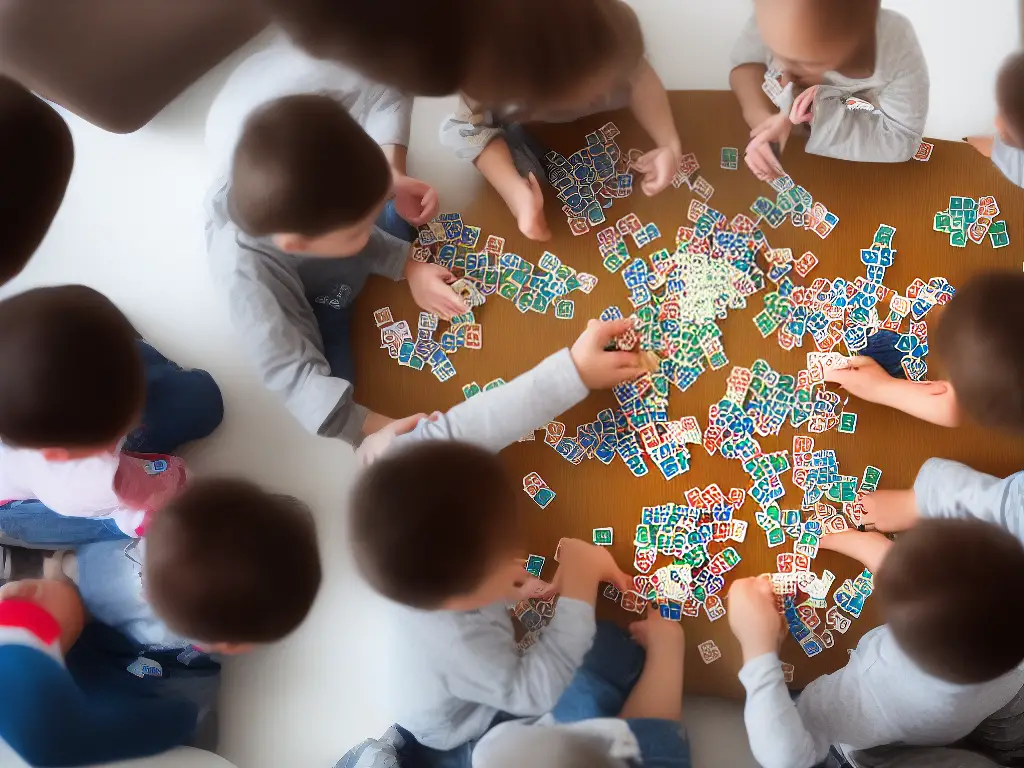
Card Game Basics
Are you ready to dive into the world of card games? Card games can be a fun and engaging way to spend quality time with friends and family. This guide will cover the fundamentals of two-player card games for kids, teaching you how to set up, deal cards, understand player roles, and ultimately, play to win!
Game Setup
- Choose a card game: There are numerous two-player card games out there, each with its own set of rules and objectives. Start with a simple one like “Go Fish,” “War,” or “Memory” to help kids learn the game mechanics.
- Preparing the deck: Most two-player card games for kids require a standard deck of 52 playing cards. Remove jokers, and shuffle the cards until they are well-mixed.
- Designate a playing area: Clear a flat space, such as a table or the floor, where both players can easily reach the deck and have room to display their cards.
Dealing Cards
- Determine the dealer: The dealer’s role is to distribute the cards to the players. Kids can decide who goes first by taking turns, drawing a high card, or using another method of your choice.
- Deal the cards: The dealer begins by giving one card at a time, face-down, to each player according to the rules of the game. The number of cards dealt varies based on the specific game (e.g., five cards for “Go Fish” and the entire deck for “War”). Make sure to follow the rules of the game you’re playing.
Roles of Players
- The dealer: As mentioned earlier, the dealer’s main role is to distribute the cards and sometimes manage the draw pile or discard pile. In most games, the dealer’s role rotates around the table after each round.
- The other player: The second player participates in the game based on the rules and objectives set out by the specific game. Their role might involve trying to accumulate cards, creating sets, or winning individual card battles.
Objectives of Winning
- Understand the game’s objective: Each card game has a specific goal that players work toward, such as capturing all the cards in “War,” matching the most pairs in “Memory,” or creating the most sets in “Go Fish.”
- Know the card values: Some games have cards with different values, meaning that certain cards offer more points or are more desired than others. Ensure you know the card hierarchy to maximize your chances of winning.
- Develop strategies: As you play more games, you’ll begin to learn various strategies to increase your chances of winning. For example, observing your opponent’s responses in “Go Fish” can give clues to the cards they hold.
Learning two-player card games for kids can provide endless hours of entertainment and is a great way to strengthen bonds. Start with this guide on the fundamentals of card game basics, and remember that practice makes perfect! As you progress and understand the mechanics, you can experiment with more advanced games and develop strategies to become a true card game master. Happy playing!

Go Fish
Go Fish is a popular, easy-to-learn card game that’s perfect for kids. The objective is to collect sets of four cards of the same rank by asking your opponent for specific cards. Here’s a step-by-step guide on how to play Go Fish with two players.
What You’ll Need:
- A standard deck of playing cards (52 cards)
- Two players
- Prepare the deck: Remove the jokers from the deck and shuffle the cards well.
- Deal the cards: Deal seven cards to each player if it’s a two-player game. If you have more than two players, deal five cards to each player instead. Place the remaining cards face down in a draw pile in the center of the playing area.
- Begin the game: The player to the left of the dealer goes first. On their turn, the player selects a card rank (e.g., fives, queens, etc.) that they currently have at least one of in their hand. They then ask the other player, “Do you have any [card rank]?”For example, if the player is looking for eights, they may ask, “Do you have any eights?”
- Respond to the request: The other player must give the first player all the cards of the requested rank that they have in their hand. If they have no cards of that rank, they respond by saying, “Go Fish.”
- Go Fish: If the responding player says “Go Fish,” the first player draws a card from the draw pile. If the drawn card is the rank they asked for, they show it to the other player, and their turn continues. If it’s not, their turn ends, and it’s the other player’s turn to ask.
- Creating sets of four: When a player collects a set of four cards of the same rank, they must place the set face up on the table. The goal is to collect as many sets of four as possible.
- Continuing the game: The game continues with players taking turns asking for specific card ranks and collecting sets of four. Remember to always ask for a card rank that you have at least one of in your hand.
- End of the game: The game ends when all sets of four cards have been collected, or when there are no more cards left in the draw pile.
- Determine the winner: The player with the most sets of four cards is the winner.
Now that you know how to play Go Fish, you can enjoy this classic two-player card game with your kids or friends. It’s a great way to teach kids about matching and memory skills while having lots of fun. Enjoy!
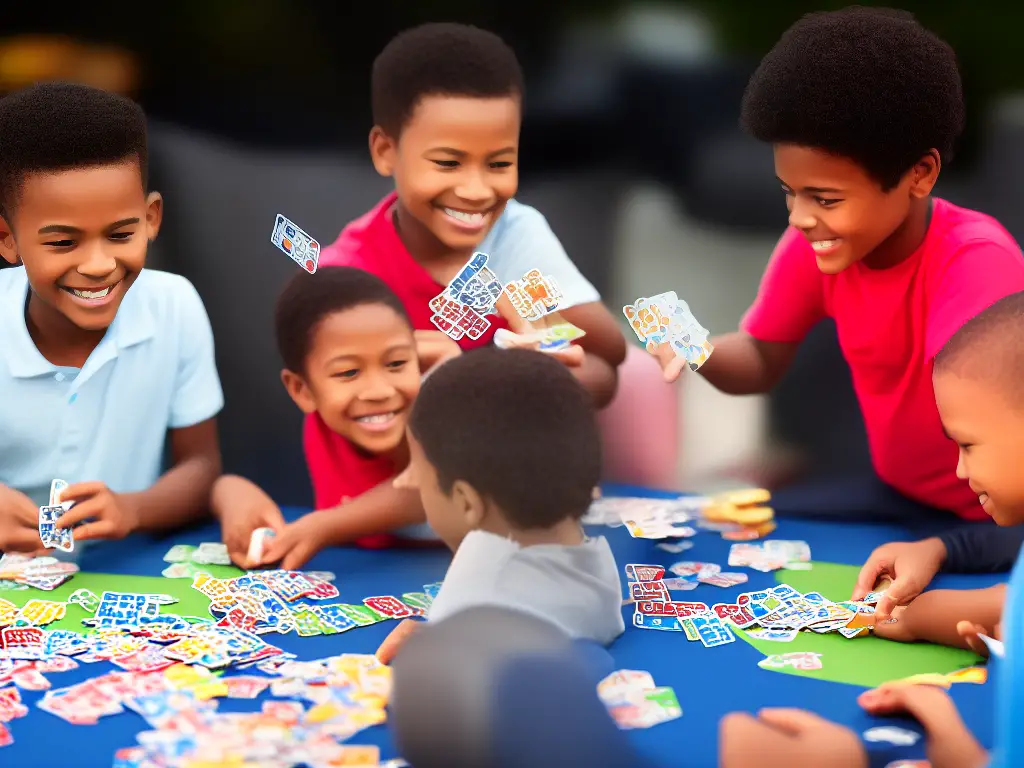
Crazy Eights
Crazy Eights is a fun and easy card game for kids that can be played with two players. The objective of the game is to be the first player to get rid of all your cards by matching suits or ranks sequentially.
What you need:
- A standard deck of 52 playing cards
Setup:
- Shuffle the deck and deal eight cards to each player. Place the remaining cards face down in the center of the table. This will be the draw pile.
- Flip the top card from the draw pile face up and place it next to the draw pile. This will be the start of the discard pile.
How to play:
- The player to the left of the dealer goes first. On their turn, the player must play a card from their hand that matches either the suit or rank (number) of the top card on the discard pile. If they cannot play a card, they must draw a card from the draw pile. If the drawn card can be played, the player should play it immediately. If it cannot be played, the player’s turn ends.
- Play continues clockwise with each player either playing a card that matches the suit or rank of the top card on the discard pile or drawing a card if they cannot play.
Special cards:
- 8s are considered wild cards and can be played on top of any card. When a player plays an 8, they must declare a new suit for the next card to be played.
- If the face-up card on the discard pile is an 8 at the beginning of the game, the first player can play any card of their choice, and the suit of that card becomes the new suit to match.
Winning the game:
- The first player to get rid of all their cards is the winner of Crazy Eights. If the draw pile runs out of cards and neither player can play a card on the discard pile, the player with the fewest cards in their hand wins the game.
Tips for playing with kids:
- To make the game more engaging and easier for kids, you can add variations such as using cards with their favorite characters or allowing them to play with fewer cards (for example, dealing five cards instead of eight) to reduce the difficulty level.
- Encourage kids to plan their moves strategically, helping them understand the importance of saving wild cards for when they’re truly needed or attempting to play their higher ranking cards earlier in the game.
- Praise your kids for their effort and good sportsmanship, regardless of winning or losing. This teaches them to enjoy the process and learning experience of the game.
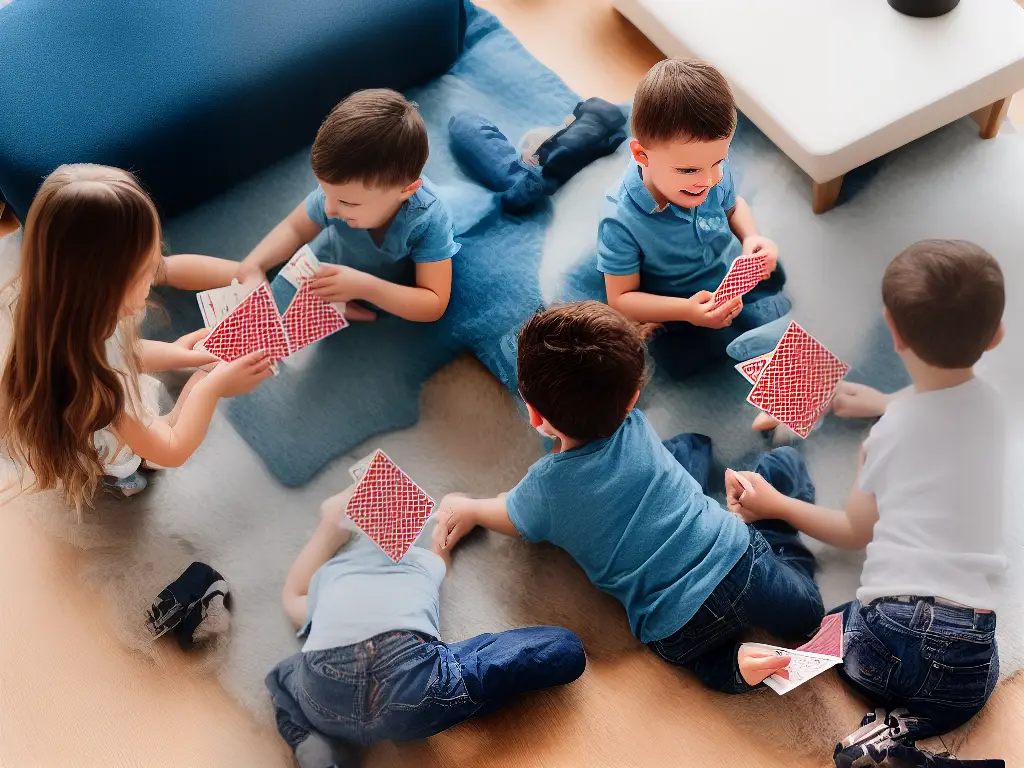
Old Maid
Old Maid is a classic card game that is perfect for kids and families. It’s a simple matching game that can be played with two or more players and is suitable for ages 4 and up. The ultimate goal is to avoid being left with the unmatchable Old Maid card at the end of the game.
Materials Needed:
- A standard deck of 52 playing cards
- Remove three Queen cards, leaving one Queen behind (this will be the Old Maid card)
- You can also use a special Old Maid card deck if you have one
Preparing the Deck:
Shuffle the remaining 49 cards well so that they are mixed up properly. If you are playing with younger kids, you might want to use fewer cards to simplify the game.
Dealing the Cards:
Deal all the cards evenly among the players, one at a time, face down. It’s okay if some players have one more card than others. The players should keep their cards hidden from the other players.
Sorting and Pairing Cards:
Each player looks at their cards, and any pairs they have (cards with the same rank) are placed face up on the table. A pair consists of two cards, such as two 5s or two Kings.
Starting the Game:
The player left of the dealer starts the game by offering their hand, face down, to the player on their left. This player chooses one card at random without looking at it and adds it to their hand.
Finding New Pairs:
The player who drew the card now checks to see if they have a new pair. If they do, they place the pair face up on the table.
Continuing the Game:
The game continues clockwise, with each player in turn offering their hand to the player on their left, who draws one card and checks for pairs. Remember, players should always hold their cards so that the other players cannot see their faces.
Discarding the Old Maid:
As the game progresses and more pairs are made, the unmatchable Old Maid card will get closer to being the only card left. Players should try to avoid drawing the Old Maid card, as the person who ends up with it loses the game.
Ending the Game:
The game ends when one player has no more cards left in their hand, meaning all other cards have been paired off and placed on the table. The player left holding the Old Maid card is the loser.
Having Fun:
Old Maid is a simple and fun card game that kids can enjoy. The element of surprise and excitement when avoiding the Old Maid card makes it an enjoyable experience for everyone involved. Be sure to encourage good sportsmanship and have fun playing with family and friends.
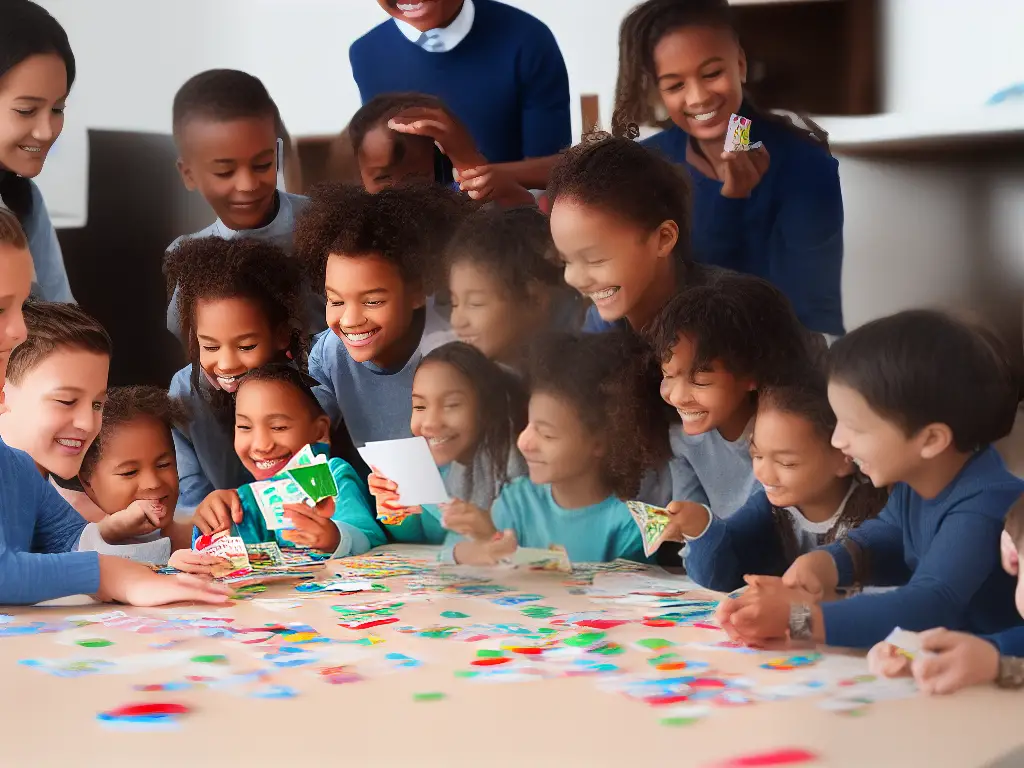
War
War is an easy and fun card game that can be enjoyed by kids and adults alike. The objective of the game is to win all the cards in the deck by comparing the value of each card with your opponent’s card.
What You’ll Need:
- A standard deck of 52 playing cards
- Two players
Setting Up the Game:
- Shuffle the deck of cards and split it evenly between the two players, with each player receiving 26 cards, face down.
- Each player should create a stack of their cards without looking at their values. This will be their draw pile.
Playing the Game:
- Both players draw the top card from their draw pile, placing it face up in the center of the playing area.
- Compare the values of the two cards on the table. The player with the higher card value wins that round and collects both cards, adding them to the bottom of their pile.
- In case both players draw cards with the same value, a “war” takes place. Each player places three cards face down from their draw pile and then draws a fourth card, placing it face up. The player with the higher value on the fourth card wins all the cards from the war, adding them to the bottom of their pile.
- The game continues until one player has won all the cards in the deck, and is declared the winner.
- Note: If a player runs out of cards during a war, they can use the cards they have already won to continue the war. If they still don’t have enough cards after using their winnings, they lose the game.
Tips and Variations:
- For younger kids, you can use fewer cards in each draw pile for a quicker game. This can also help them learn to compare the values of the cards more easily.
- To increase the difficulty for older kids or adults, you can add additional “war” steps, such as placing five or seven cards face down instead of three during a war.
- You can allow players to choose whether they want to play a high card or a low card during a regular turn, making the game more strategic.
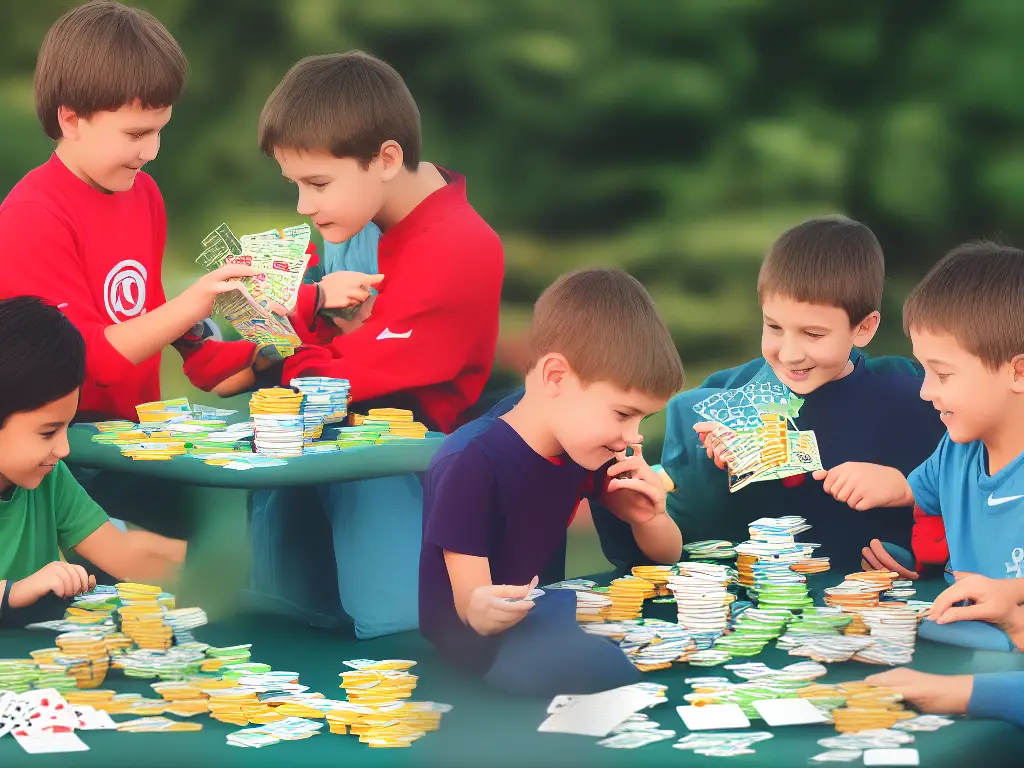
Memory
Memory, also known as Concentration, is a fun and engaging card game for kids that helps in developing focus, attention, and memory skills. It involves trying to match pairs of face-down cards by turning over two cards at a time and remembering their locations. Here’s how to play Memory:
What You’ll Need:
- A deck of cards (You can start with a smaller deck of 20-40 cards for younger kids and increase as they get more proficient)
Setup:
- Remove any jokers from the deck and shuffle the cards thoroughly.
- Spread the cards face-down in a grid pattern on a flat surface (e.g., 4×5 or 5×6 grid, depending on the number of cards).
How to Play:
- The youngest player goes first. On their turn, the player flips over two cards, so they are face-up. Make sure both players can see the cards.
- If the two cards are a matching pair (same rank and color, e.g., a red 5 and another red 5, or a black king and another black king), the player takes the pair and places it in front of them. They then get another turn to flip over two more cards.
- If the two cards flipped over do not match, the player must turn them back face-down in their original locations. It’s essential to remember the locations and values of the cards, as this information will help both players in future turns.
- The next player now takes their turn, following the same steps – flipping over two cards and trying to find a matching pair.
- The game continues with players taking turns flipping cards and trying to match pairs until all the pairs have been found and the grid is empty.
- The player with the most matched pairs at the end of the game is the winner.
Tips to Make the Game More Fun:
- Use themed or specially designed cards to add a fun visual element.
- Adjust the difficulty level by using more cards or introducing special rules, such as matching cards based on their suit or rank.
- Reward matched pairs with small tokens or points to make the gameplay more competitive.
- For an extra challenge, you could also use three or four cards to make a match, depending on the deck used.
Play Memory with your kids to make learning entertaining and promote cognitive skills development. Enjoy the game and happy matching!
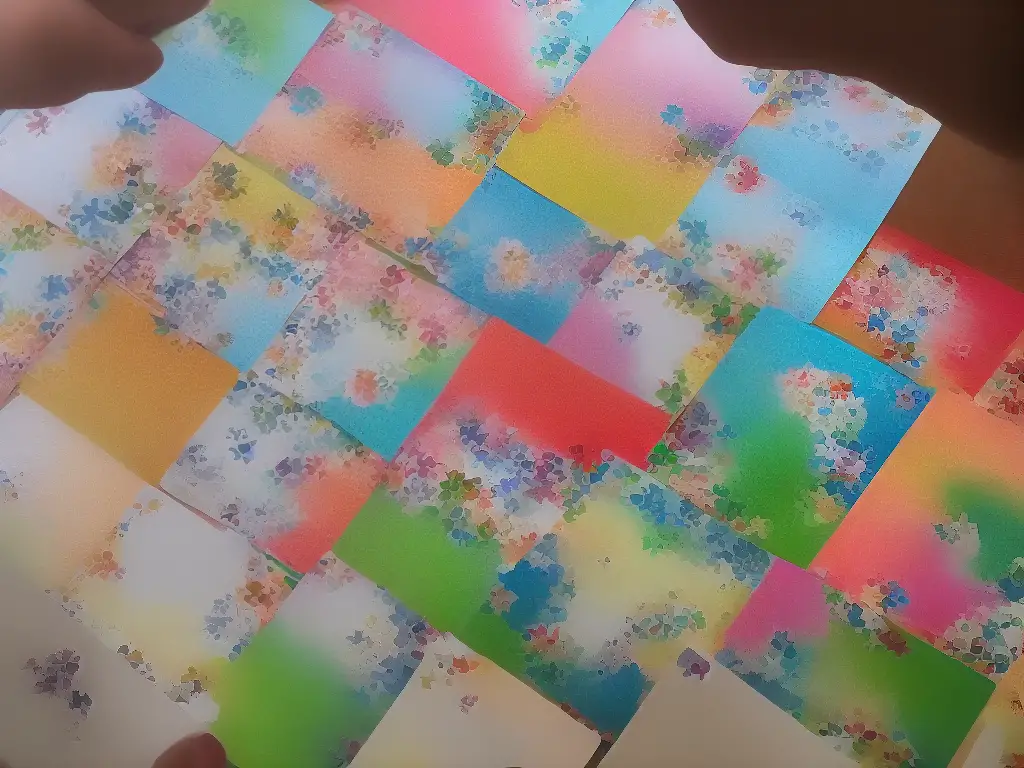
Rummy
Rummy is a popular card game that can be enjoyed by players of all ages. In this guide, we will cover the basics of how to play Rummy, as well as variations suitable for children, such as Gin Rummy or a simplified version of Rummy.
Objective:
The objective of Rummy is to be the first player to get rid of all your cards by forming sets or runs. A set consists of three or four cards of the same rank (such as 8, 8, 8) while a run consists of three or more consecutive cards of the same suit (such as 5, 6, 7 of hearts).
Setup:
1. Shuffle a standard deck of 52 cards.
2. Deal 10 cards to each player. (For a simpler version, you can deal 7 cards.)
3. Place the remaining cards face down in the center of the table. This forms the draw pile.
4. Flip the top card of the draw pile and place it face up beside the draw pile. This forms the discard pile.
How to Play:
1. The person to the left of the dealer goes first.
2. On your turn, you must first draw a card. You can choose to draw either the top card from the draw pile or the top card on the discard pile.
3. After drawing, if you can form a set or a run with the cards in your hand, you may lay it down on the table in front of you (called “melding”). You are allowed to add cards to sets or runs that are already on the table.
4. To end your turn, you must discard one card from your hand, placing it face up on the discard pile.
5. Play continues clockwise around the table, with each player taking turns drawing and discarding cards.
6. The first player to get rid of all of their cards by forming sets and runs, and discarding a final card, wins the game!
Variations for Children:
1. Gin Rummy: In Gin Rummy, players try to create sets and runs in their hands instead of laying them down on the table. The game is played until one player has formed all their cards into sets and runs and discarded a final card. They then reveal their hand to the other player, and the opponent’s deadwood cards (cards not part of a set or run) are counted as points. The player with the lowest score wins.
2. Simplified Rummy: For younger children, you can simplify the game by reducing the number of cards dealt to each player (such as 7 cards) and limiting the strictness of the rules for forming sets and runs. For example, you can allow runs to consist of consecutive cards in any suit, rather than requiring the same suit.
Remember that the key to Rummy is to be the first one to get rid of all your cards by forming sets and runs. Enjoy playing this classic card game with your kids and have fun bonding over a friendly match of Rummy!

Snap
Snap is a fun and easy-to-learn card game suitable for all ages. The objective of the game is to win all the cards by being the first to shout ‘Snap!’ when two identical cards are revealed.
Instructions:
- Prepare the deck:
- If you are using a standard deck of 52 playing cards, remove the Jokers.
- Shuffle the deck well to ensure a random order of the cards.
- Deal the cards:
- The dealer should deal the entire deck of cards, face down, evenly between the two players.
- The players should not look at their cards or arrange them in any way.
- Start playing:
- The player on the dealer’s left (or choose randomly) goes first.
- The first player should take the top card from their pile and place it face up on the table in the center, so both players can easily see the card.
- The second player should do the same, creating a new separate pile of face-up cards.
- Continue the game:
- Each player will take turns flipping the top card from their own pile face up and placing it on their own face-up pile, one at a time.
- Shouting ‘Snap’:
- When two consecutive face-up cards on the table have the same rank (e.g., two 5s, two Kings, etc.), the first player to shout ‘Snap!’ wins both piles of face-up cards.
- The winning player should place the face-up cards they won on the bottom of their face-down pile.
- If the players shout ‘Snap!’ at the same time, the face-up piles are combined and placed in the center of the table. This creates a ‘Snap pot’.
- The game continues as normal, and the player who calls ‘Snap!’ correctly when the next matching pair comes up wins the entire ‘Snap pot’.
- Losing cards:
- When a player runs out of face-down cards, they must take a break from playing until the next ‘Snap!’ occurs.
- That player can then try to gain new cards by shouting ‘Snap!’ when a matching pair appears.
- Keep playing:
- Continue taking turns, flipping cards, and calling ‘Snap!’ when pairs appear.
- The game ends when one player wins all the cards, or when a player accumulates a significant majority of the cards and the other player agrees to forfeit the game.
- Winning the game:
- The player who ultimately collects all the cards or has the most cards when the game ends is the winner of the game.
Now that you have learned how to play Snap, gather a deck of cards and a friend and have fun playing this quick and exciting card game!
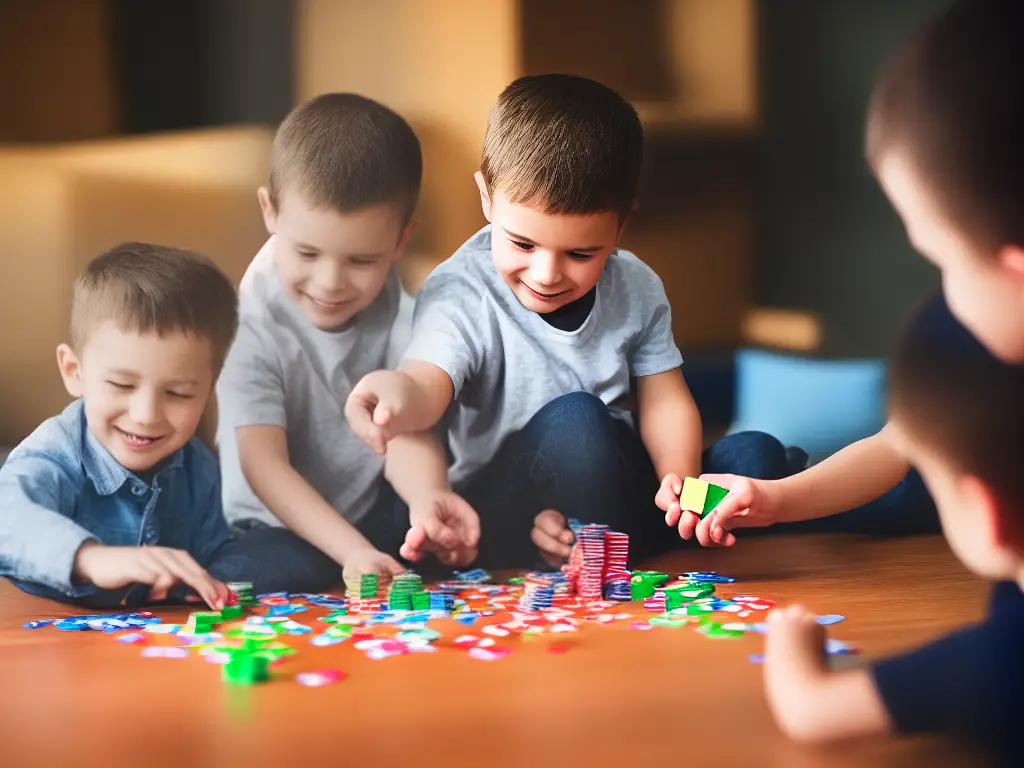
Beggar-My-Neighbor
Beggar-My-Neighbor, sometimes also known as “Strip Jack Naked” or “Beat Your Neighbor Out of Doors,” is a simple and fun card game for kids that’s easy to learn and can be played with just two players. The goal of the game is to win all of your opponent’s cards. While the game is mostly based on luck, it can still be entertaining for both kids and adults.
Materials:
-
- A standard deck of 52 playing cards.
Setup:
-
- One person shuffles the deck and then deals the entire deck, face-down, distributing cards one at a time between both players. Each player will have a stack of 26 cards. It’s important to not look at the cards in your hand.
- Cards have the following rank order, from highest to lowest: King, Queen, Jack, 10, 9, 8, 7, 6, 5, 4, 3, 2, Ace.
How to play Beggar-My-Neighbor:
-
- Players sit facing each other, with their stack of cards in front of them.
- The player to the left of the dealer begins by taking the top card from their stack and placing it face-up in the center of the playing area to create a central pile. (Make sure not to show the card to your opponent while doing this.)
- The other player now does the same, placing their top card face-up on top of the pile.
- The game continues with players taking turns to play the top card from their stack, face-up onto the central pile.
- If a player reveals a ‘number card’ (2-10), the play simply passes to the other player, who then plays their next card face-up onto the pile.
- If a player reveals a face card (King, Queen, or Jack), this is a penalty card, and the other player must play a specific number of face-down cards on top of the central pile based on the face card that was played:
- King: 4 face-down cards
- Queen: 3 face-down cards
- Jack: 2 face-down cards
- As the player places down each face-down card, if they reveal another face card, the process repeats itself, and the play passes to the other player, who must play the required number of face-down cards based on the new face card.
- If a player reveals a number card while paying the penalty, the player who played the initial face card wins the pile of cards (including the face card) and adds them face-down to the bottom of their stack.
- If a player has no cards left in their hand while paying the penalty, they lose the game.
Winning the game:
-
- The game continues with players taking turns playing cards face-up onto the central pile, winning piles with face cards, and adding won cards to their stacks.
- The objective is to win all the cards in the deck. The first player to have all 52 cards in their stack wins the game.
Remember, Beggar-My-Neighbor is mostly a game of luck, so just have fun and enjoy playing with your friends or family.”
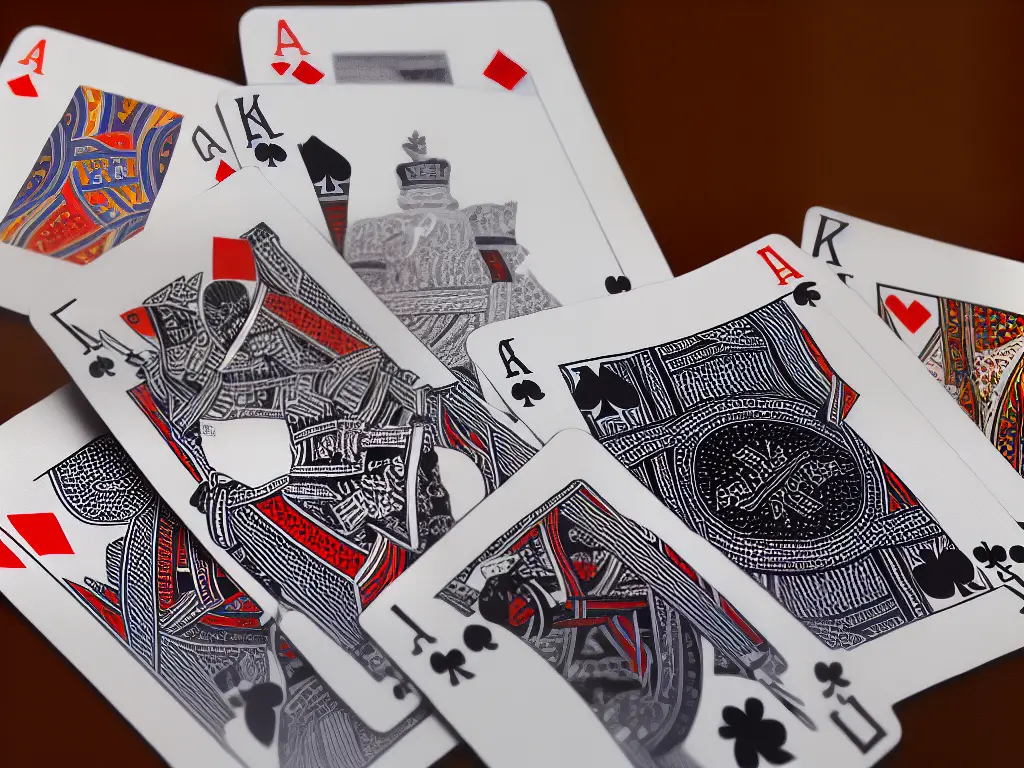
Practicing and Playing
Objective: To practice and play various two-player card games with a partner or family member to become comfortable with the rules and strategies for each game.
Materials Needed:
-
- A standard deck of playing cards (52 cards, no Jokers)
- A partner or family member to play with
- A table or flat surface to play on
Step 1: Choose a Two-Player Card Game
Pick a two-player card game that you want to practice and play. There are many games to choose from, but for this guide, we will focus on these three popular and easy-to-learn games: “War,” “Go Fish,” and “Rummy.”
Step 2: Learn the Rules of the Game
Take some time to learn the rules of the two-player card game you have chosen. Make sure you and your partner understand how to play, the objective of the game, and any game-specific strategies. You can find online resources, books, or videos to learn the rules of each game.
Here is a brief overview of each game:
-
- War: War is a straightforward game where the goal is to capture all of your opponent’s cards. Players take turns flipping one card each, with the higher card winning both cards. In the case of a tie, a “war” occurs, and each player must place three additional cards face down and one face-up. The player with the higher face-up card wins all the cards in play.
- Go Fish: The objective of Go Fish is to collect as many sets of four matching cards as possible. Players take turns asking each other if they have a specific card to complete a set. If the other player has the requested card, they must hand it over. If not, they say, “Go fish!” and the asking player must draw a card from the deck. The game ends when one player runs out of cards or the deck runs out, and the player with the most sets wins.
- Rummy: The goal of Rummy is to get rid of all your cards by forming “melds,” which are sets of three or four matching cards or sequences of three or more consecutive cards of the same suit. Players take turns drawing and discarding cards, trying to create melds in their hands. The first player to get rid of all their cards wins the game.
Step 3: Practice Playing the Game
Start practicing the two-player card game with your partner. Take turns shuffling and dealing the cards and going through each step of the game. Make sure you both understand the rules, the flow of the game, and any strategies that might be useful as you play. Ask questions and clarify any points of confusion.
Step 4: Play the Game for Real
Once you and your partner feel comfortable with the rules and flow of the game, start playing for real. Keep it friendly and fun and remember that the goal is to improve your skills and enjoy your time together. You can keep track of wins and losses, but don’t let competitiveness get in the way of enjoying the game and learning together.
Step 5: Practice Different Games
After you and your partner have become comfortable with one game, try learning and practicing other two-player card games. This will help you both become more versatile players and keep things fresh and exciting. Repeatedly play the games to find which ones you like best and to master the different strategies and skills required for each game.
Conclusion: Practicing and playing two-player card games with a partner or family member is an excellent way to develop card game skills, promote quality bonding time, and enjoy a fun and educational activity together. Remember to be patient and supportive as you both learn and improve, and, most importantly, have fun!
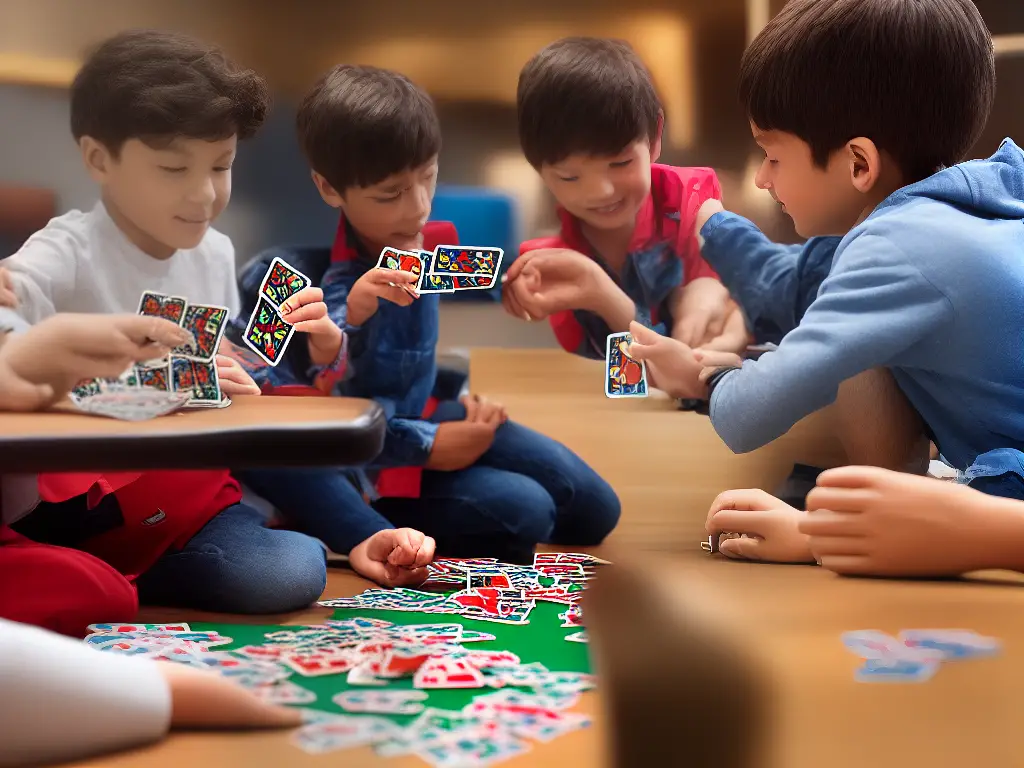
Now that you have learned several two-player card games for kids, you’re equipped with the knowledge to start playing, practicing, and enjoying this timeless form of entertainment. As you and your children become more comfortable with the rules and strategies for each game, you’ll find that card games can be a fantastic way to bond with family, improve mental focus, and create lasting memories together. So grab a deck of cards, find a partner, and let the fun begin!
